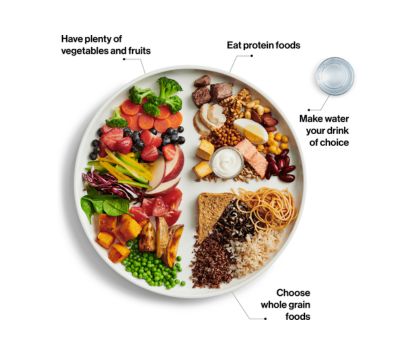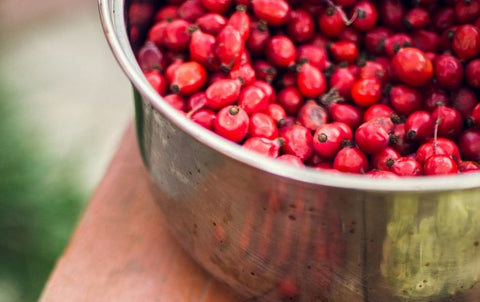Everything you need to know about Canada's new food guide... In 10 easy-to-digest points.
You may have heard that Health Canada recently released a new food guide. But, how much do you know about it? And is it really that different from our old food guide?
Well, yes.
It’s quite different (and worth learning about). One of the most notable changes can be seen right on the front cover. No longer do you see a rainbow filled with drawings of food.
Instead, this unrelatable image has been replaced with a real picture of real food... Finally

If you ask us, this image is way easier to understand. (The rest of Canada seems to agree too!).
Although this cleared up some of the confusion around portion sizes, many Canadians still have questions…
Exactly what changed in Canada’s new food guide? Why is it important to follow Canada’s food guide anyway? And what does a balanced diet look like?
Rest assured, this post will not only cover these questions but will also empower you to make better food choices suited to your unique lifestyle.
Keep reading to see the top 10 things you need to know about Canada’s new food guide.
When was Canada’s Food Guide last updated?
Canada’s new food guide was officially released in early 2019, replacing the much older 2007 version.
Needless to say, this “makeover” was well overdue.
Here’s a link to the history of Canada's food guides, if you are interested!
As mentioned earlier, the new food guide is very different from the old one...
Specifically, the new guide takes into account valuable feedback from stakeholders and Canadians and provides different resources for different types of users.
This is quite different than the previous all-in-one approach, which Canadians found pretty hard to interpret.
Further, the new mission “Eat well. Live well.” has received tons of praise for properly reflecting the importance of healthy eating behaviours on quality of life.
That said: Healthy eating isn’t just about getting an adequate amount of nutrients any more, it’s about creating a sustainable lifestyle that supports your growth and wellness.
When you have a chance, we suggest checking out the full guide. But, just in case you’re running short on time, we have put together the top 10 important takeaways from Canada’s new food guide.
Let’s get started.
1. No more confusing food groups and portion sizes.
If you don’t remember how confusing the old food guide was, let us remind you…
Women between 19-50 years old were previously advised to consume 7-8 servings of vegetables and fruit, 6-7 servings of grain products, 2 servings of milk and alternatives, and another 2 servings of meat and alternatives.
The problem? Barely anyone knows what a serving size even is!
Thankfully, the new guide ditched these confusing portion size recommendations and opted for real-life examples and images that are easy for the average consumer to relate to.
2. Mindfulness is not just for meditation, it’s also for eating.
What is mindful eating? Essentially, it comes down to remaining present and aware during your meals.
It’s important to note that mindful eating isn’t a skill that you develop overnight. Rather, it takes a little practice.
Fortunately, Health Canada offered a few helpful tips for everyday mindful eating:
- Create a healthy eating environment
- Use your senses (taste, smell, sight, emotions, etc.)
- Reflect on your eating habits
Following the tips above will help you develop a healthier (and less complicated) relationship with food.
3. Your new go-to drink: Water
This one comes as no surprise… Rather than opting for pop, juice, sugary beverages, or specialty coffees (filled with sugar and fat), make the smart choice and drink water instead.
Water is essential to staying hydrated and plays a vital role in your health.
Tip: If regular water is too boring for you, try adding in some fruit, mint leaves, or natural flavour additives!
Canada’s new food guide also includes alternate healthy drink choices, such as unsweetened low-fat milk, fortified plant-based beverages, and coffee and teas.
4. Planning is the ultimate key to eating right.
The new food guide places a large emphasis on cooking more often. One of the best ways to make this possible, as recommended by Health Canada, is through meal planning.
By creating a smart eating strategy and planning your meals, you will not only save money, but you will also find it easier to make better food choices.
And that’s the goal, right?
5. Make (extra) room for vegetables and fruits.
Canada’s new guidelines for healthy eating call for LOTS of vegetables and fruits. That is… Half your entire plate!
The fibre, vitamins, and minerals that are found in vegetables and fruits make these foods an essential part of a balanced diet.
Consuming more vegetables and fruits daily can lower your risk of heart disease, according to Health Canada.
With so much variety, the options for veggie and fruit-filled dishes are endless! Check out these healthy recipes by Health Canada for some more inspiration.
6. Your environment matters. A lot.
Where you eat matters. Taking the time to create “a positive eating environment”, as the guide calls it, is much more important than you may realize…
Your eating habits are largely influenced by who you eat with, where you eat, your mood, and a variety of other factors.
Here are the guide’s recommendations for creating a positive eating environment:
- Eat with friends and family
- Make your eating environment attractive
- Play comforting music in the background
7. Protein is more than just meat. The emphasis is now on plant-based options.
What do you normally think of when you hear the word “protein”? Most likely, the first words that popped up in your head were chicken, beef, pork, or... MEAT!
While the new food guide still recommends lean meats and seafood, they are now encouraging consumers to move towards more plant-based protein options.
What are some plant-based protein foods?
- Nuts and seeds
- Beans, peas, and lentils
- Fortified soy beverages
- Tofu
- Soybeans and soy products
If you find it difficult to meet your protein requirements, you might want to try supplementing with protein powders.
8. Food skills are worth developing.
There’s a lot of talk about developing smart food skills in the new guide. But what exactly are food skills anyway?
Put simply, food skills are the knowledge required to make educated food choices.
Health Canada recommends educating yourself on how to read nutritional information, especially on food labels. They also suggest honing in on your meal planning and cooking skills.
Food skills aren’t just good to have, they empower you to create a healthier lifestyle.
9. Whole grains all the way.
While the old food guide included both refined and whole grain items, the new guide is very clear that whole grains are the better option.
This is because “whole grain foods include all parts of the grain, [while] refined grains have some parts of the grain removed during processing” (*).
Additionally, whole grain foods’ high fibre content can lower your risk for several major diseases, such as stroke, cancer, and heart disease (*).
Here are a few of the recommended whole-grain options in the guide:
- Whole grain pasta
- Whole grain bread
- Brown, whole grain rice
- Quinoa
- Whole grain oats and oatmeal
If you want some more whole-grain ideas, try using this delicious whole-grain pancake and waffle mix!
10. Got milk? Slimming down on dairy.
The new food guide cover image shows no explicit recommendations for dairy, leaving many quite confused... But don’t worry, there’s a good reason for this.
Dairy products are often high in fat, sodium, and sugar.
Plus, many people are actually lactose intolerant (and don’t even know it!). Interestingly, the old food groups “milk and alternatives” and “meat and alternatives” are no longer standalone food groups.
Rather, they are now mushed together into one big “protein category”.
Note: If you aren’t quite ready to leave dairy behind, here are a few of the guide’s (brief) daily recommendations:
- Low-fat cheese
- Unsweetened low-fat yogurt
- Unsweetened low-fat milk
Putting it Altogether
In this post, we went over the key changes to Canada’s new food guide.
As a quick reminder, here are the top 10 important takeaways:
- No more confusing food groups and portion sizes.
- Mindfulness is not just for meditation, it’s also for eating.
- Your new go-to drink: Water
- Planning is the ultimate key to eating right.
- Make (extra) room for vegetables and fruits.
- Your environment matters. A lot.
- Protein is more than just meat. The emphasis is now on plant-based options.
- Food skills are worth developing.
- Whole grains all the way.
- Got milk? Trimming down on dairy intake.
If you would like to learn more about Health Canada’s recommendations, here are a few helpful resources we think you might like:
Healthy Eating Recommendations
Finally, we hope you enjoyed our breakdown of Canada’s new food guide. Happy eating!
P.S. Let us know in the comments below if you have any questions or comments. We would also love to hear what your favourite healthy eating tip is!






